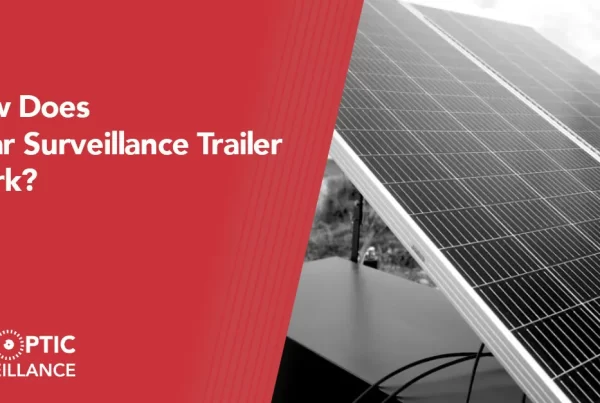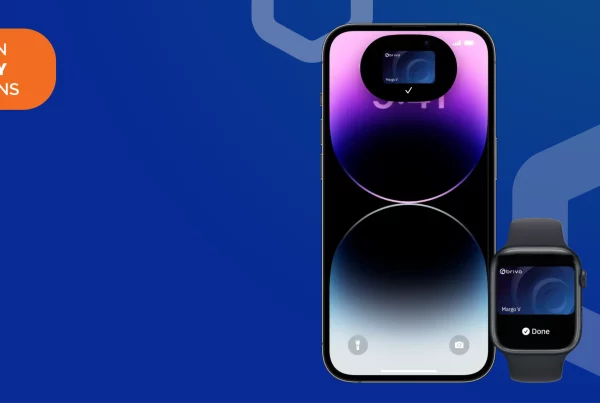A complete reference to key card access systems and key fob entry systems
Key fob entry systems and electronic key card access systems are productive ways to let your employees enter and exit their offices safely and easily. There are several methods available for keyless entry control. The many key card and key fob door entry systems, their pros and disadvantages, the variables affecting the cost of key card door locks, and how to select the best door access security solution for your company are all covered in this thorough reference on security card reader systems.
Table of Content: Key Card Access Systems | Key Fob Entry Systems
- How does key card door entry work?
- Key cards and key fob types
- Door lock systems using key cards and key fobs
- Advantages of key card access
- Key card and fob access disadvantages
- Key card and fob system alternatives
- Key card and fob access control system cost analysis
- Upgrading your access control system
Get help with your key card and fob system today
How does key card door entry work?
A plastic card, ID badge, or other electronic key card that you swipe in front of a scanner to unlock a door or gain admission to a facility is certainly something you’ve seen or used before. Although key card access control systems have been in use for a while, businesses all over the world frequently use them as a security measure. Parking garages, office buildings with several tenants, HOA communities with shared amenity zones, and huge business offices with controlled access to particular areas all often employ key card and key fob door entry systems.
How access control systems with card readers work
A door access card reader system that regulates who may enter the building and when can provide users peace of mind. Security cards for doors, card readers for doors, and electronic key card door locks are the three essential parts of card reader access control systems. With electric and magnetic card door lock systems, the door is unlocked by either proximity activation or a card swipe.
The key card credential presented at the door card reader is recognized and authorized by the access control card system, which then signals the magnetic door lock to unlock. The user may then open the door using the push-bar, lever, or lockset thanks to the magnetic card door lock system. Magnetic card door lock systems instantly return the door to a closed position after the user closes the door behind them, ensuring that the door is always securely locked.
Electronic key card door lock systems can be triggered by proximity, by tapping the door card reader, or by swiping a card through the reader, depending on the kind of card reader entry systems installed in the building. Certain door access card reader systems also offer mobile unlocks via smartphone applications.
Employing a card reader for door access or a key card for gate access control aids in keeping unauthorized people outside while making admission for authorized users simple. Moreover, security cards for doors can be configured with distinct permissions. Houston Security Solutions’s card reader access control systems may be set up to grant user- or group-specific access rights. A card access door lock system also keeps track of entrance occurrences, which aids organizations in maintaining their security.

Key cards and key fob types
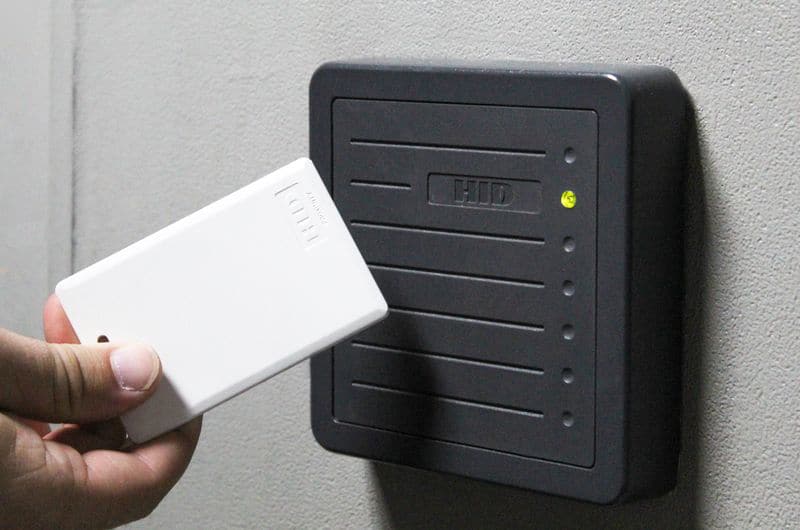
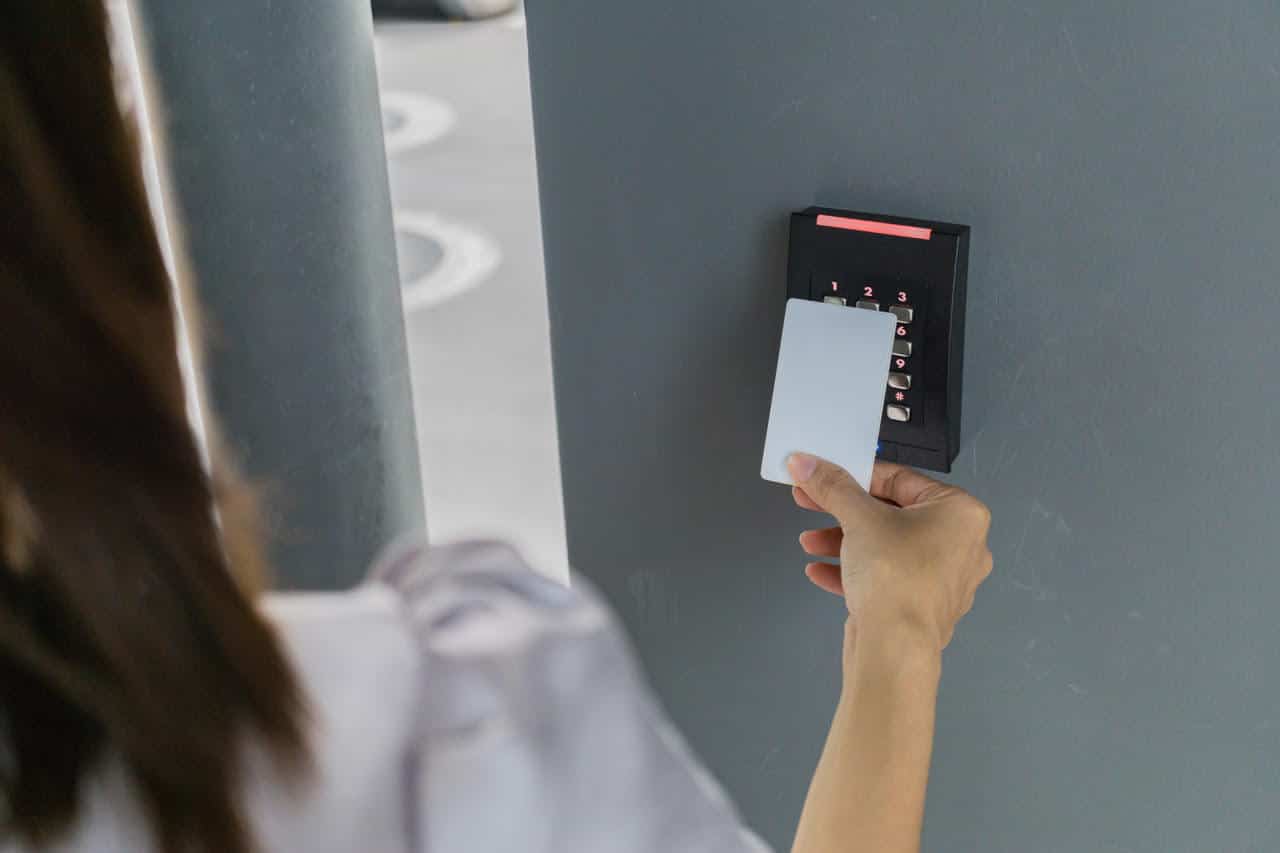
Key cards and fobs come in a wide variety of styles nowadays. Even though they all serve the same purpose, it’s crucial to understand the differences between the most popular alternatives when picking the finest key card door access for your location. The number of doors you need to secure, the number of individuals utilizing the key card door access system, and the required level of security will determine which access control system is best for you. The three most popular key cards and fobs for access control are listed below.
Wiegand key cards
The majority of Wiegand key cards, one of the first types of key cards developed in the 1970s, are utilized with outdated security systems. They contain unique binary information that is unaffected by magnetic forces. As these cards don’t use a microprocessor or other fragile components, they tend to be more durable, albeit outdated, solutions.
Today’s world, readers and scanners are still connected to controllers using the Wiegand protocol as the conventional interface. Even more recent fingerprint and key card scanners utilise readers that translate the data into a Wiegand number.
Swipe key cards
A swipe card has a magnetic stripe along one side of the key card that stores the credential information, similar to your standard credit card system. The user only has to swipe their card through a magnetic reader to start an activity, whether it’s to pay for a purchase or open a door. Swipe key cards provide for audit trails and may be tracked individually. For bigger enterprises where numerous individuals need access to the same regions, a swipe card door access control system provides a simple and affordable security option.
Entry systems using card swipes are frequently less costly than those with proximity card readers. A swipe card door lock does have some important disadvantages, though. In congested lobbies where they can create a bottleneck or in parking garages where it might be challenging to swipe the card from inside a car, a swipe card door lock is not a good choice. The wear and tear on card swipe entry systems also tends to be greater, necessitating more regular maintenance as the system gets older.
Proximity cards, RFID cards, and RFID fobs
This access method utilizes Radio Frequency Identification (RFID) to communicate data contained on the card to a reader, making it one of the most popular forms of security key cards. Depending on your demands and the security access you select, RFID enabled key cards and key fob systems can function on several frequency bands. The card typically has to be quite close to the reader for the data to transfer with proximity cards and RFID key fobs.
Key fobs are an excellent choice for keyless entry systems in bigger building complexes because they can be customized to provide time limitations and unique location permissions on individual components. Because of this, office buildings frequently employ a key fob system for their commercial tenants. For two-factor authentication, certain key fob door entry systems additionally incorporate built-in PIN pads.
Smart cards are a high-frequency RFID key card alternative that send data via Near-Field Communication (NFC). As seen in contactless payment systems and credit cards, these cards often have greater storage space than ordinary RFID cards and contain encryption for improved security.

Door lock systems using key cards and key fobs
Commercial key card door lock systems can be designed with various reader types and locking mechanisms in addition to the credentials themselves. Commercial key card door locks, sometimes known as “smart locks,” are more technologically advanced than conventional door locks and can increase facility security.
Keypad and PIN readers
This kind of keyless locking system substitutes a PIN code or password for a key card or fob as the credential. To open the door, a user will need to enter their PIN on a keypad. Although these kinds of electronic door lock scanners are practical, users must remember a passcode, and they frequently need to be changed to preserve security. Keypad access control readers are sometimes used in conjunction with commercial key card door locks for high-security or limited access zones, requiring the user to first scan their key card or fob and then input a password in order to obtain admission.
RFID proximity key fob door locks
This kind of door access reader reads user credentials using RFID technology. To unlock the door with a key card door lock system, users need just show their approved key card or key fob to the RFID reader. Since it offers the most versatility and can be used in a variety of situations, this type of key fob door lock system is the most popular in commercial access control systems. Controlling access to office buildings, parking lots, elevators, and IT server rooms is made easy using key card door locks. Moreover, business key card door lock systems provide more detailed access rights.
Biometric door readers
A biometric key card door system, used for entry in government, financial, and medical establishments, increases security. For user authentication, biometric access control systems employ a person’s fingerprint, retina scan, or facial recognition software. Several commercial key card door lock systems incorporate biometrics as a kind of two-factor authentication, requiring the user to first complete a biometric scan in order to get access before scanning a key card credential.
Video key card readers
For improved door security, a commercial key card reader with video capability has become the new norm. Organizations have access to live video of every access event with a vantage point of where it occurs thanks to video key card readers. If you want to get the best return on investment, look for video and door intercom readers with high-definition cameras, support for all access methods, such as encrypted key cards, mobile credentials, and multi-technology support for low- and high-frequency credentials, as well as support for all access methods.
Wireless key card door locks
Wireless key card door lock systems are an affordable solution to extend access control to interior entrances since battery-operated wireless door locks don’t require hardwiring.
By the use of ENGAGE Gateway technology, Houston Security Solutions effortlessly interacts with Allegion’s Schlage® NDEB, LEB, and ControlTM wireless locks, providing quick mobile access with native Bluetooth connectivity.
Migrating to a single credential system is simple thanks to Brivo’s cloud-to-cloud interoperability with Schlage wireless locks.
A wireless, keyless door lock system that supports key cards, fobs, and mobile applications will maximize versatility and scalability.
For securing both private apartments and shared entrances in residential complexes and hotels, wireless key fob door lock systems are perfect.
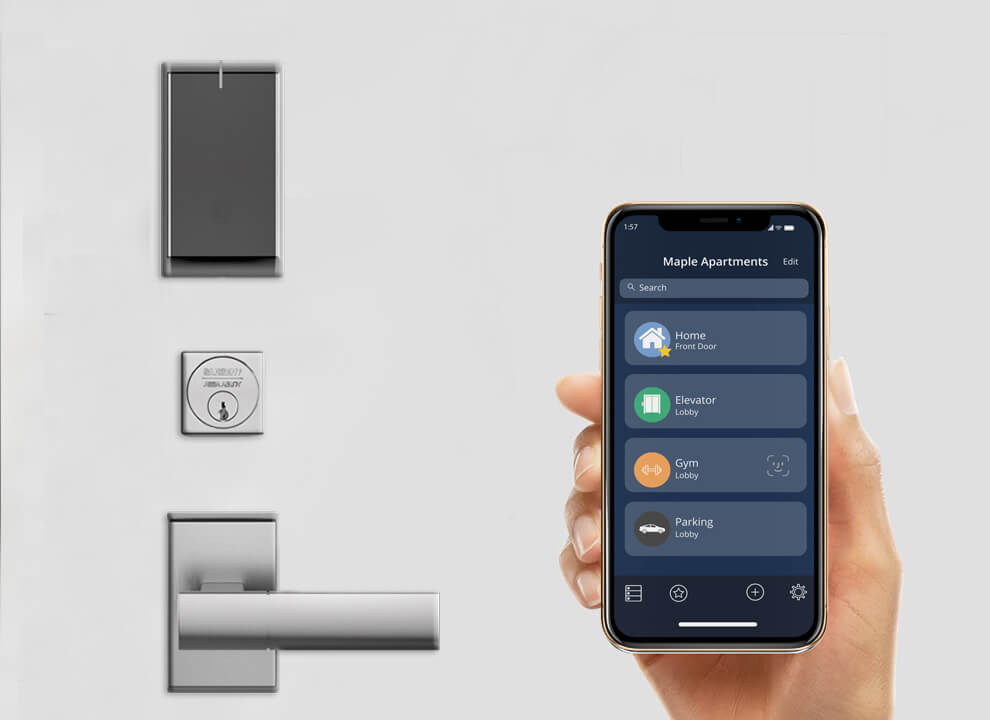
Advantages of key card access
The majority of businesses use electronic key card systems to give employees simple access control. Key cards are preferable to actual keys since it is simple to deactivate one particular card at a time rather than having to rekey all of your locks if someone loses a card, resigns, or gets fired. Consider the advantages of employing key cards as your access control solution while conducting a safety audit.
Security cards for doors may be purchased for not too much money, and key card access systems are frequently more cost-efficient than alternative technologies. But, if your business is big, be aware of the rising expenses linked to growing and upgrading the key cards for your workforce.
The hardware components of key card door entry readers need little maintenance.
With a key card entry system, access may be quickly established or modified for certain credentials, such as in the event that a card is lost or stolen.
As opposed to a typical key that everyone has a copy of, each individual may be given their own unique physical credential, which offers more security.
Once put into operation, card key door locks and swipe card locks are simple to use and require little training. For commercial or office entrance, the majority of individuals have no problem utilizing a security card lock system.
Employees can carry key cards, RFID badges, and key fobs more conveniently than key rings since they are frequently compact and fit into a pocketbook or pocket.
Systems for reading security cards have a wide variety of uses and are extremely adaptable. Security cards for the doors make it simple to secure a workplace, and proximity technology works well with key card gate access systems as well.
Security systems with key card access enhance security awareness and reaction. Depending on the readers and connections your system offers, key card access is typically trackable and can give an audit trail, allowing you to determine who used their ID or key fob at particular entry points and times.
Key card and fob access disadvantages

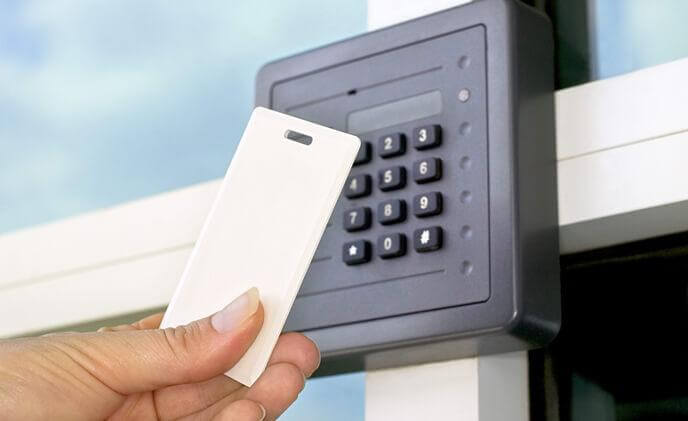
Key card door entry systems have several serious limitations that you should be aware of, despite the fact that they initially cost less than many other options.
Key card systems’ security vulnerabilities
Swipe cards are unstable and are sometimes vulnerable to magnetic stripe breakage, which renders them illegible. While swipe cards are initially affordable, the cost of maintaining the reader and the cards over time will increase owing to frequent wear and tear. Swipe cards are also cumbersome since they need to be used with a free hand and up close.
Wiegand key cards are simple to duplicate, increasing the likelihood that a security breach may occur in your building. Given that the Wiegand protocol has been in use since the 1970s, hackers have had plenty of time to develop quick and efficient techniques to compromise Wiegand systems. In reality, practically anyone could hack your system by purchasing a key card copying equipment for as low as $10.
Key cards are simple to lose. Anyone can enter your place by picking up a key card that has been lost or stolen. The average 40,000 person firm loses 10,350 key cards and fobs annually, according to Buildings.com. With a traditional key card access system, your place is less safe without two-factor authentication or additional security measures.
As the keys are being created or registered for your key card entry system, waiting periods might vary. As you wait for new credentials to come, the security of your facility may be compromised since receiving new key cards might take weeks.
Key cards are difficult to use and costly to maintain.
Key cards do not operate hands-free. While traditional keys and locks are undoubtedly more difficult to use than key cards, searching for a key card may create a backup in busy lobbies or doors. Also, it’s practically hard to pull a key card out of your wallet when you have your hands full.
Administrators will deal with misplaced, stolen, or forgotten keys on a continuing basis. People lose wallets and keys frequently for a variety of reasons, including human forgetfulness. Your managers are required to give new key cards or guest passes if an employee misplaces or forgets theirs, as well as to temporarily or permanently deactivate the previous credential.
Key card registration and deactivation take time. The additional time it takes to setup individual cards and fobs, particularly during periods of increased hiring or brief furloughs, is probably taking away from your managers’ ability to do other crucial activities.
To physically hand individuals their key cards, you must meet with them. Avoiding any unnecessary physical contact at work will be crucial after COVID-19. Although key card and key fob door entry systems involve a physical credential that must be handed to each person who wants one, they may occasionally be set remotely.
Systems for key card door entry are not scalable.
If your company’s key fob system is powered by an antiquated platform, you won’t be able to manage several buildings remotely or from a single hub. Each location or site requires a dedicated on-premises server.
For organizations that need to act swiftly, delays in providing and revoking credentials on a key card or key fob access system entail a lengthier on-boarding procedure and possible loss of income.
You will need to order and send brand-new cards to the whole company if your branding changes or you need to add a new location.
Several key cards must be carried by users who have access rights at numerous locations. Nobody enjoys worrying about having the correct key card at the correct building.
Key card and fob system alternatives
It’s no secret that managers are already overworked, so if your key card security system is making things worse rather than better for them, it might be time to find a different approach. Some of the strains and difficulties can be eliminated with a smartphone-based keyless entry control system.
Mobile credentials are more secure than key cards since they provide multi-factor authentication and end-to-end encryption.
Access control using smartphones reduces the likelihood of users disclosing their credentials. Compared to a real key card or key fob, people are less inclined to share their smartphone with a coworker.
Several of the disadvantages of key cards and fobs are eliminated by cloud-based security management. This sort of technology doesn’t need regional servers, thus it can simply be expanded to encompass additional doors and building sites while costing less to maintain for your company.
Your administrators may quickly modify credentials, cancel access, and customize entries whenever they want from any location thanks to remote management in the cloud.
Guest passes are simple to manage by email or text message, and they may be set to expire once the access is no longer required. Less to be concerned about!
Access control that is entirely touchless. When COVID-19 limitations are released, the ability to enter and depart hands-free will make it easier for enterprises to reopen. A mobile access system like Houston Security Solutions, which integrates automated door opener hardware for germ-free entry and leverages Bluetooth, Wi-Fi, and cellular data in its proprietary Triple Unlock technology, may be set up to respond to motion detection.
A security solution that is mobile app-based makes it simpler to always have the most recent version of your software since upgrades can be loaded automatically without causing any system downtime.
Key card and fob access control system cost analysis
Any business that wants to install a security system must make a significant financial commitment, and access control system costs are a major consideration. The number of readers and control panels you need, the hardware you purchase, and the credentials the system requires will all affect your ultimate cost when creating an access control budget.
A key card access reader system can initially appear to be the more affordable choice. Depending on the type of reader you choose and the wiring already present in your room, you might anticipate paying $2,500 or more to have a key card door access reader installed. Key card access control does come with additional charges, too, and they can easily mount over time.
You will need to buy key cards—a tangible credential—for each user. You’ll need to buy extra cards not only for your current employees but also for new hiring, lost or stolen cards, and cards that may be used temporarily for guest access. If you have several buildings or locations, you will need to buy unique cards for each one and make sure that everybody who needs to access those places has the appropriate key cards.
Often, key cards need to be manually set up on a local server. This implies that your administrators will need to set aside some time to update the system with fresh data, establish permissions, and create the credential. Your labor charges will take that extra time into account.
Key card systems from the past will need pricey software updates and on-site maintenance. When an installation has to pull up a truck, as well as each time there is an upgrade or servicing at your facility, the majority of access control providers charge fees.
An access control system must be scalable without increasing overhead expenses, especially for multi-location firms and expanding companies. When weighing the long-term financial advantages of access control systems, a mobile solution might result in surprisingly substantial savings. The majority of smartphone-based access readers cost a little extra to install initially, but they end up saving money over time, increasing their return on investment.
With a mobile access control system, your smartphone acts as your credential, so you don’t need to buy, manage, or distribute key cards. Also, people are far less likely to misplace their phone or leave it at home, thus fewer temporary permits will be required.
On the same system, you may give each user access that are particular to the site. Mobile credentials may be used for all of your sites, anywhere in the globe, rather than having to buy new key cards for each facility.
On-premise servers are eliminated by cloud-based access control. This means that you won’t have to worry about paying for costly maintenance, and improvements to access control software may be made right away over the cloud.
The ability to remotely administer all of your locations is another feature of a cloud-based platform that reduces costs. It takes only a few clicks to create a new user, and it’s quick and simple to revoke access. Also, you no longer need to waste time travelling to the office to let someone in who lost their key card thanks to remote unlock options.
Upgrading your access control system
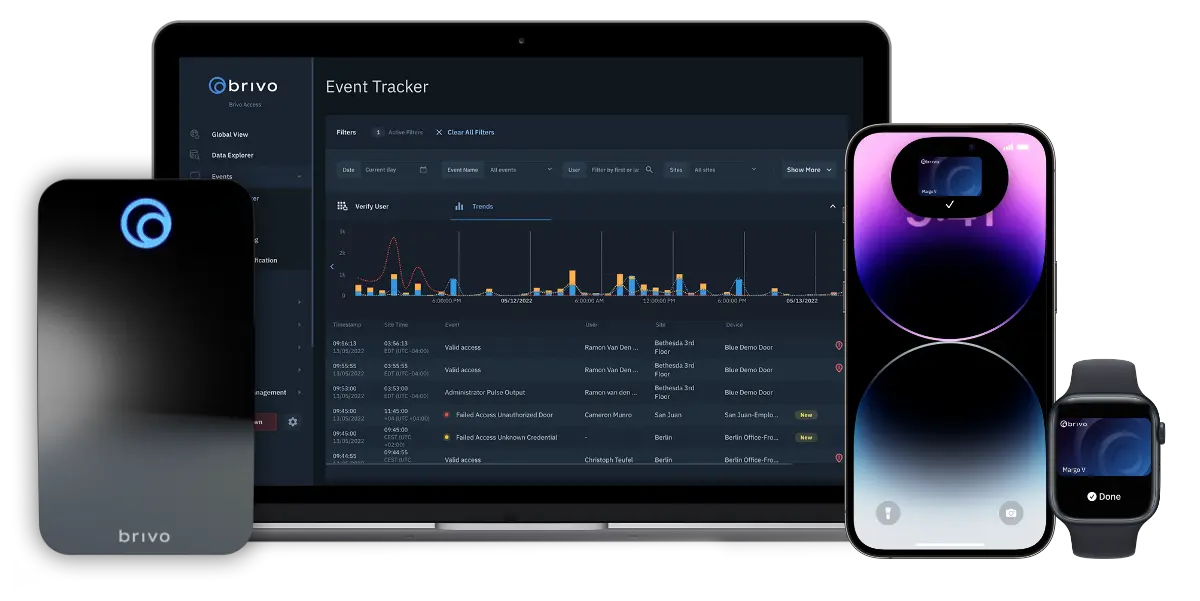
The addition of smartphone access control to your security system is fantastic, but what if you still want to use key cards? You can have it all with Houston Security Solutions’ state-of-the-art smartphone access control solution. The cutting-edge cloud-based solution is built for maximum interoperability and flexibility to fulfill your specific security requirements.
In order to safeguard your company, Houston Security Solutions readers may be set up to enable unlock requests made via the company’s mobile app, the Apple Watch app, tablets that already have the app loaded, bespoke key cards and fobs, or a Mobile Pass..
To make cards exceedingly difficult to copy or duplicate, Houston Security Solutions provides DESFire EV2 128-bit AES cryptographic key cards with digitally signed identities.
While operating in hybrid mode with a legacy card system, MIFARE RFID cards are also supported for backwards compatibility with legacy RFID systems.
You may interact with other tools and apps, such as VMS and surveillance software, using an open API platform like that provided by Houston Security Solutions.
Each Houston Security Solutions client has the option to display just the data that is most pertinent to them thanks to mobile-optimized bespoke dashboards, regardless of whether they are managing a worldwide security network on many displays or monitoring a single entry on a tablet or phone.
Contact Houston Security Solutions to see how our smartphone access system can seamlessly connect with your current set up if you want a keyless access system that delivers scalability, dependability, security, and interoperability.
Houston Security Solutions Access Control Installers Service Areas
Access Control System & Installer in Houston, Texas
Top Houston access control contractors, installers, and companies
Learn MoreAccess Control System & Installer in Baytown, Texas
Top Baytown access control contractors, installers, and companies
Learn MoreAccess Control System & Installer in Deer Park, Texas
Top Deer Park access control contractors, installers, and companies
Learn More




